
“They're quite lovely, even if they smell bad” (anonymous survey respondent)
Introduction: How We Think Stuff Works and How Stuff Really Works (or Doesn’t)
In this second article about personal training/lifting equipment, I have even more questions and fewer answers than on the one about belts. In my technical literature review, I found one article. To my great disappointment, it was one I wrote 13 years ago.
The reasons are the same I explained for the scarcity of research on the belt (which is abundant in comparison to the wrist wrap): “science push and market pull”. There is not enough of either.
Athletic wrist wraps are very popular and wrist orthoses (orthopedic devices used to prevent movement of joints during treatment, prevent joint injury or align joints) even more. Just like orthopedic low back belt-like devices are no help to understand how an athletic lifting belt works, wrist orthoses, about which there is more research, are of little use in our case.
Not all is darkness, though: 262 athletes gave their input in an interesting survey about their use of wrist wraps.
Basics About the Wrist Wrap
Summary chart:
What Does a Wrist Wrap Look Like
Wrist wraps are made from different materials and with different lengths, from simple slings to complex devices combining glove parts, thumb sleeves, and grip aid elements. Some are made of an elastic material that restricts wrist bending without totally immobilizing the joint, plus any other desired effect such as aiding in grip, restricting thumb or whole hand movement. Only powerlifting federations have strict rules concerning them. If you don’t compete in powerlifting, the options to choose from are close to infinite since they include whatever you can improvise or create.
This is part of my original collection:
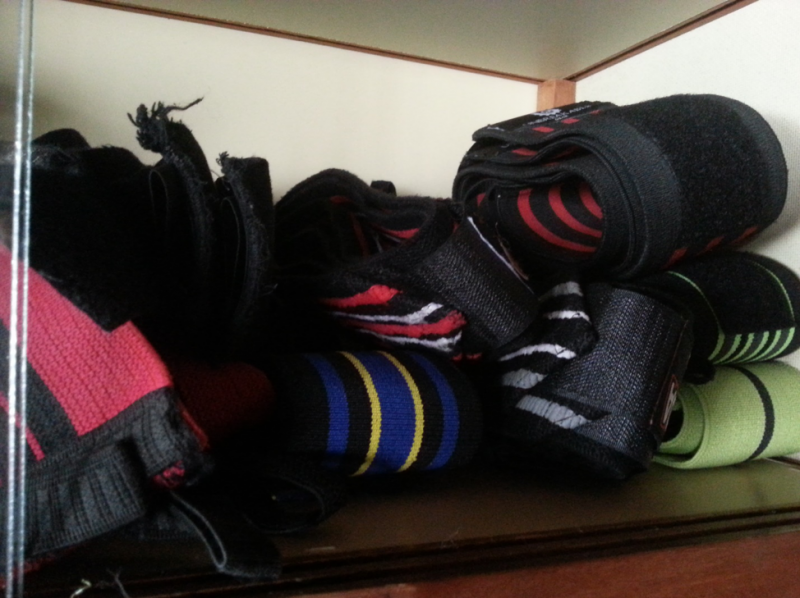
I owned, tested and used over 50 wrist wraps of different brands, models and lengths. Like everyone, I finally settled for three: one softer, for Olympic Weightlifting training and lighter powerlifts and two tougher, for heavier bench presses.
Personal equipment choice is strictly individual. There are several decent brands in the market, but what will help the lifter is determined by a unique combination of variables. For example: I have benign joint hypermobility, inherited from my father and passed on to my daughter. People with hypermobility frequently also have injury-prone joints and instability in weight-bearing joints. Wrist wraps and their proper use is essential for me. There is no study about this but apparently, I am an exception among high-performance benchers and the percentage of us with hypermobility is probably different from the percentage in the general population (personal communication from experienced coaches and lifters).
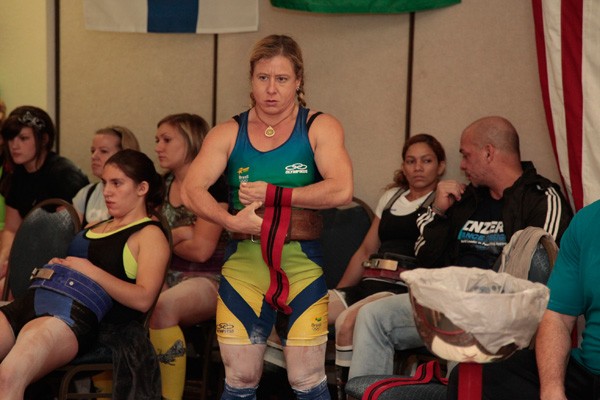
Atlanta, 2011, an international powerlifting competition: the wrist wrap wrapping moment is usually part of the athlete’s focus ritual. This is a regular stretching sling wrap with Velcro adjustment. This is the longest allowed wrap in powerlifting (36 inches).
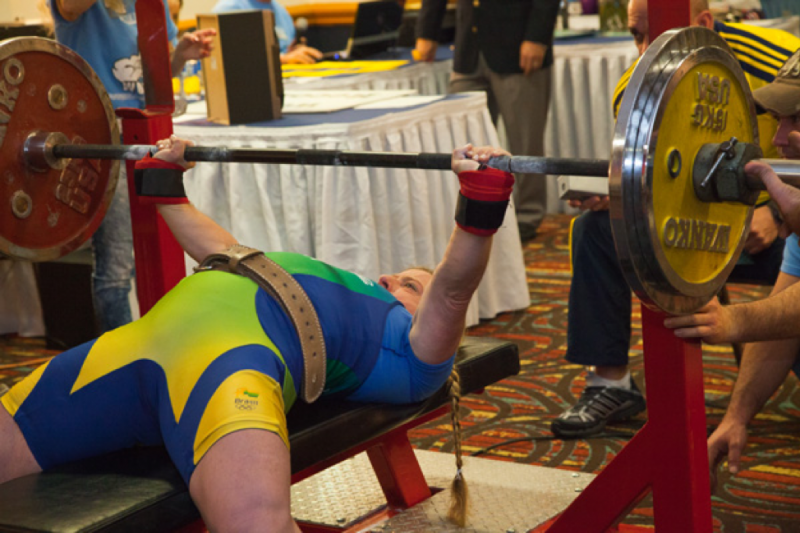
Same competition, lockout position on the bench press.
Other types of modern wrist wraps:
Leather wrist wraps:
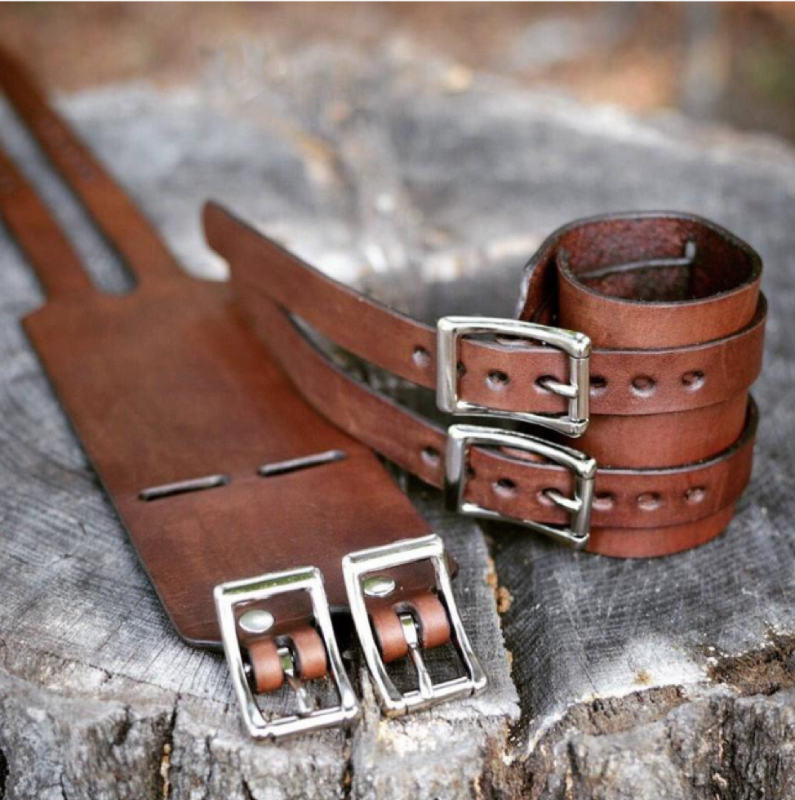
From “Full Grain Leather”
Chinese and Russian non-stretch products:
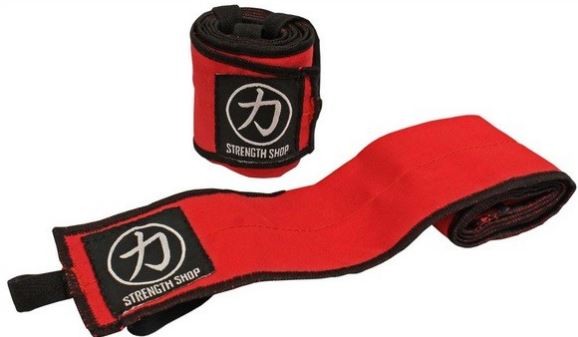
From Strengthshop.de
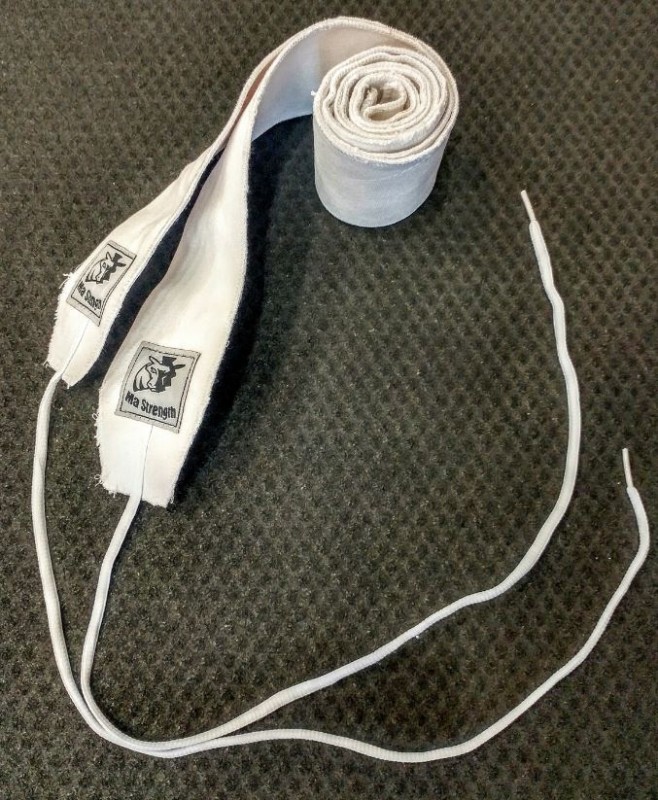
From MA Strength
Most sports don’t have much on the way of wrist wrap specification even when their players usually wear some type of wrist protection in competition, like in tennis. Their rulebook doesn't restrict the athlete's options.

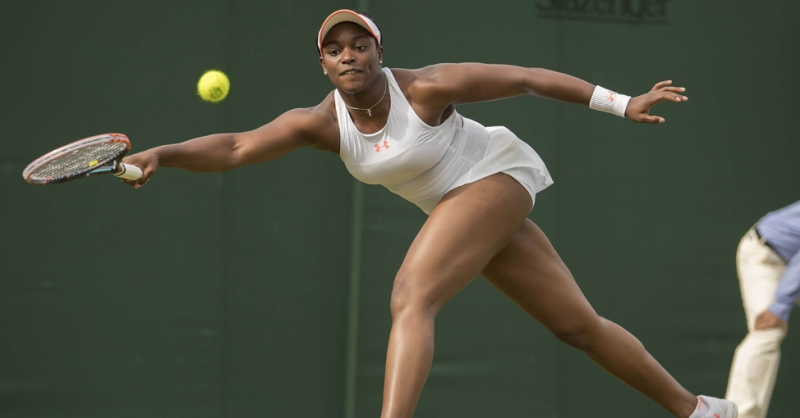
In combat sports, wrist protection is critical but most rulebooks contain specifications only for gloves and design, including sponsors logos: see UFC promotional guidelines and World Boxing Council rules and regulations.
Wrist wrapping procedures are sophisticated and require a high level of expertise:
There are several athletic wrist protection products in the market. Some combine wrist protection and a bar grip device, which will be the subject of another article. Many of the orthoses available may be suitable for lifters and may be permitted by their competitive federation.
Competition Wrist Wraps Specifications
Olympic Weightlifting
According to the International Weightlifting Federation:
"4.5.1 Bandages are non-adhesive wraps made of a variety of materials; most common materials are gauze, medical crepe, neoprene/rubber or leather.
4.5.1.1 There is no limit to the length of the bandages.
4.5.1.3 Bandages may be worn both on the inner and outer surface of the hands and may be attached to the wrist.”
In Olympic Weightlifting competitions, several different types of wraps are used. Some international elite-level athletes prefer non-elastic materials including cloth and leather.
Here are some examples:
Gold medalist Shi Zhiyong, Athens 2004, using what appears to be a leather two-buckle wrist support, similar to those seen in USPTO patents from the early XXth century:
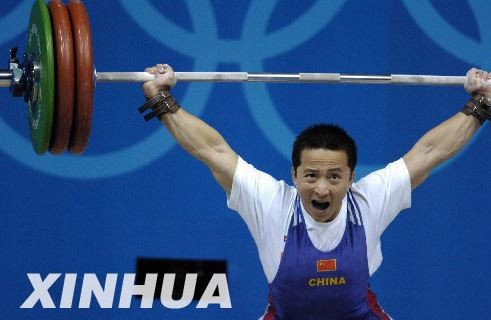
Credit: News Guangdong 08/17/2004
2018 University World Champion Maude Charron using non-stretch cotton wraps:
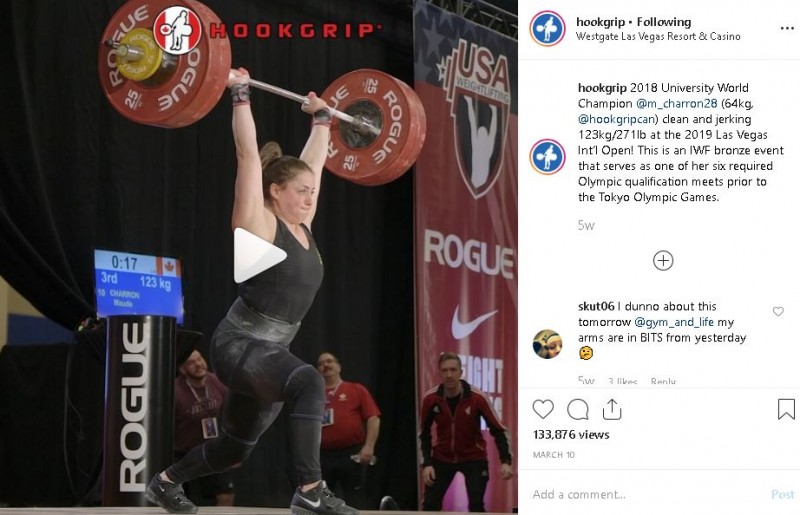
Credit: Hookgrip, March 10, 2019
Raattanawong Wamalun at the 2018 World Championship wearing a bandage that covers a long extension of her forearm:
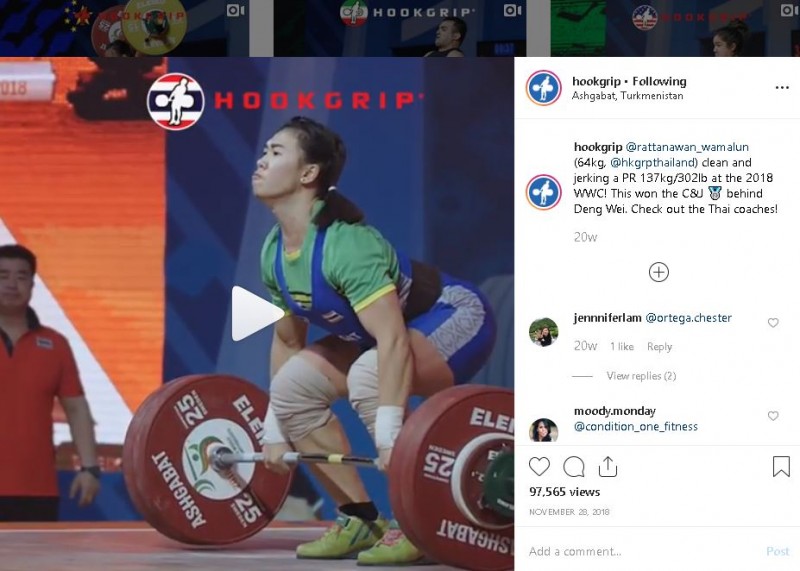
Credit: Hookgrip, November 28, 2018
Personal communication from Olympic weightlifting athletes suggests that they also use “powerlifting style” wrist wraps, with a preference for shorter and more flexible wraps.
Powerlifting
According to the International Powerlifting Federation:
Here are some models carried by elitefts.
The Strongman Corporation doesn’t provide technical specifications for wrist wraps allowed in competition.
Precursors and Technological Innovation Pathways
The precursors of modern wrist wraps as well as wrist orthoses are probably early work injury protection devices. The earliest documents we have are USPTO patents that date back to the beginning of the XXth century.
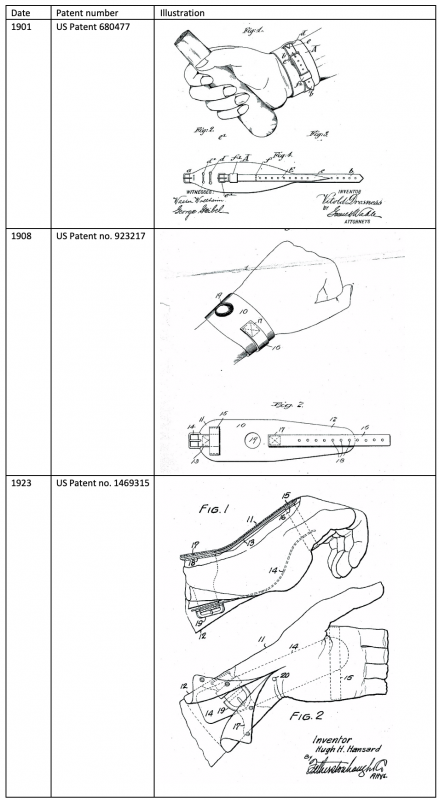
From then on, the two routes took independent paths.
The State of the Art
Patents are technical documents that must list references just like a scientific peer-reviewed article. They are not scientific articles but rather legal documents. Detailed referencing of the state of the art in patents is made to support the legal claims made in the filed patent.
Relevant scientific information to understand wrist wraps is related to two topics: wrist, elbow and shoulder injuries and joint hypermobility.
Shoulder, Elbow and Wrist Injuries: The Role of Wrist Extension
Wrist wraps were developed as protective devices for strenuous work involving arms and. In sports in general, wrist wraps protect the athlete from elbow and wrist injuries by restricting forced or voluntary backward and sideways wrist movement.
Upper body injuries are common in sports, involving the shoulder, the elbow, and the wrists. Two classes of injury may be distinguished: overuse (chronic) injuries and acute injuries. Elbow overuse injuries include musculotendinous injuries, ulnar nerve injuries and ligamentous injuries (Rettig 1998).
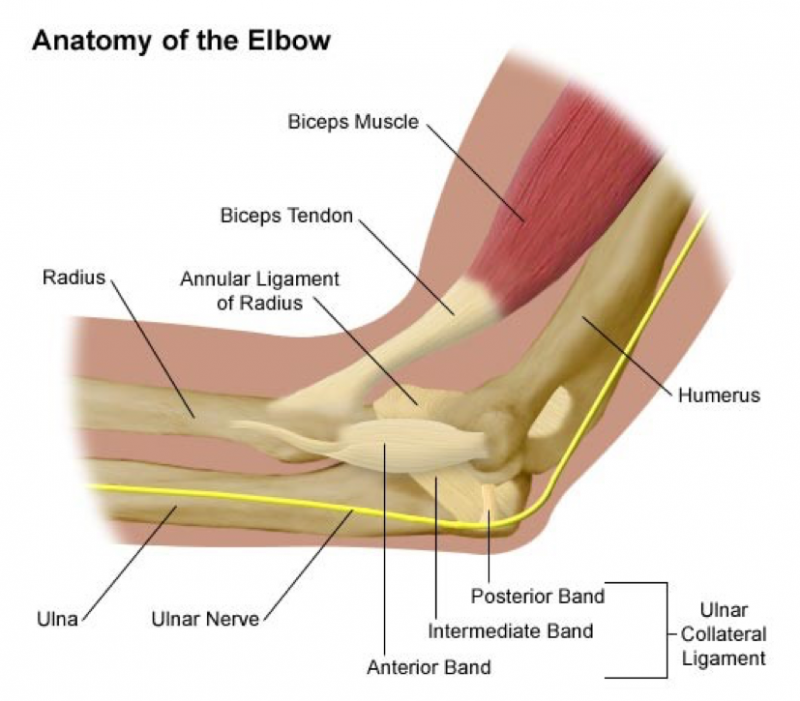
From: Yale-New Haven Hospital Health Library
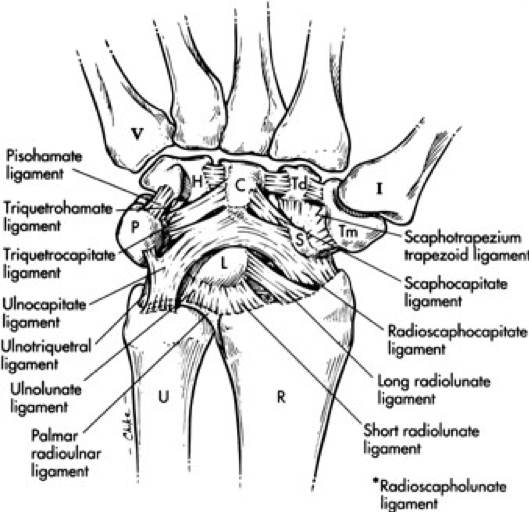
From: University of Pennsylvania Health Systems – Penn Orthopaedics
In a 2005 study carried out by the Institute of Sport and Recreation Research at New Zealand (Keogh et al 2006), 36% of all reported injuries in powerlifting involved the shoulder and 11% involved the elbow. Wrists were not included in the questionnaire. Later studies reported similar findings (Strömbäck et al 2018). Many elbow injuries, though, are a later consequence of wrist overuse or trauma. Field and Savoie (1998) reported that lateral epicondylitis occurs among 50% of athletes that use overhead arm motions. In spite of being an elbow injury, the onset of lateral epicondylitis begins with the excessive use of the wrist extensor musculature. Most elbow injuries are chronic, overuse injuries (Safran 2004).
Restriction of wrist backward, forward and sideways bending may contribute to preventing such wrist originated injuries. The wrist wrap effectively serves this purpose.
Bellow is a table of common elbow injuries for different sports, according to Frostick et al (1999). Weight training, in general, is associated with ulnar nerve disorders.
From: Frostick, S.P., Mohammad, M. and Ritchie, D.A. 1999. “Sport injuries of the elbow”. J. Sports Med. 33;301-311, p. 301.
In their review, Frostick et all (1999) present several versions for the onset of ulnar nerve injuries. Elbow flexion reduces cubital tunnel area and may, therefore, contribute to the entrapment syndrome if inflammation and repetitive stress are also present. Chronic elbow instability seems to be frequently associated with ulnar nerve injuries. Both conditions are present at bench press training and competition. Apparently, wrist wraps not only restrict wrist flexion but also help to stabilize the elbow during flexion.
Wrist Instability and Hypermobility
Only a licensed health professional can properly diagnose you with joint hypermobility. You can check some simple tests here and here (Mc Kean et al 2014).
Hypermobility or joint laxity may or may not be associated with pathological symptoms (Ercolani et al 2008). If you are a lifter or even a regular strength training practitioner, it is unlikely that you have pathological hypermobility syndrome.
Studies contrast Generalized Joint Hypermobility (GJH) with Joint Hypermobility Syndrome (JHS). GJH is fairly common among healthy individuals and more prevalent among females. A recent study showed that the prevalence of GJH was 26.2% overall (females 36.7 %, males 13.7 %). Prevalence of JHS was 19.5 % overall (females 24.5 %, males 13.7 %). Injury rates were not significantly different for individuals who had GJH vs. those who did not have GJH (Russek et al 2016).
Hypermobility syndrome is poorly understood and still controversial. In the wrist, is a form of carpal instability (wrist instability) not necessarily associated with any injury (Carlsen and Shin 2008). The genetic basis of hypermobility and joint instability remains largely unknown (Ercolani et al 2008, Malfait et al 2006).
People with joint hypermobility and wrist instability can have a harder time keeping wrist alignment during lifts such as the bench press, the snatch or the clean and jerk. I have joint hypermobility and although I have won several bench press world championships and broken world records, placing 6th all time in my weight class in 2015, I have never been able to avoid excessive wrist extension during the bench press and I need my wrist wraps from warm-up weight up. Not using them causes extreme instability and pain. This is what a heavy bench press looks like for me:
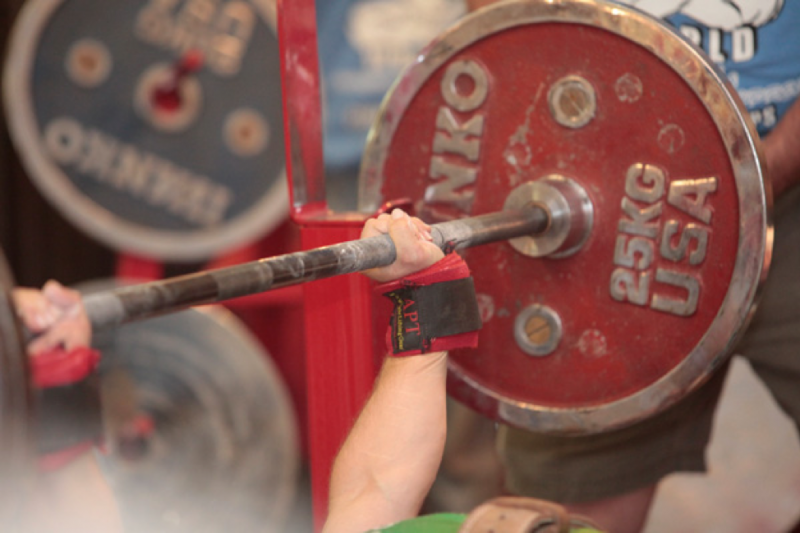
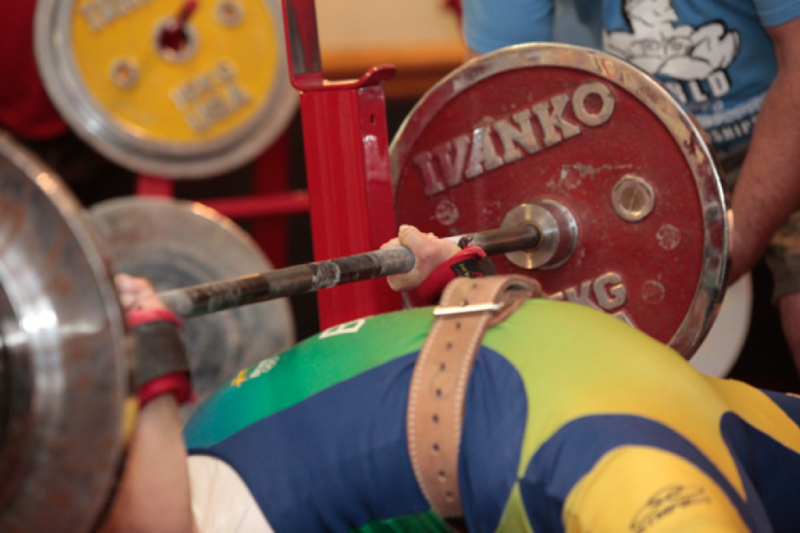
How Do Athletes Use the Wrist Wrap: The Survey
I created a short survey for athletes and strength training practitioners in order to understand their use of the wrist wrap. The survey received 262 responses. Athletes from 5 different sports responded, as well as strength training practitioners not competing in any sport:
Most respondents were male, concentrated in their late twenties, although athletes in their late thirties, early forties and even older were well represented:
Most people who own wrist wraps have more than one pair:
That makes sense considering what was mentioned before: this type of equipment is very individual and the athlete may feel different wraps are optimal for different situations.
The preferred length of the wrist wraps they own is useful information for those looking into buying their first pair. A 12-inch wrist wrap is usually too short to provide any support and a 36 inch takes forever to wrap:
Most respondents were powerlifters, and in that sport, the bench press is the lift where wrist stability is most challenged. The response below reflects that:
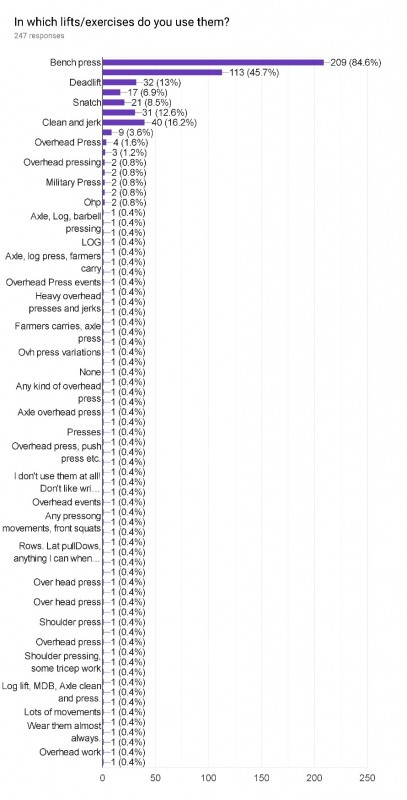
The question concerning when the wrist wrap is used must be put into context: the first answer refers to a training session (every training session as opposed to just some training sessions). The second answer concerns lifting intensity:
The majority of respondents feel that the wrist wraps provide stability although approximately half of them also perceive them as performance equipment:
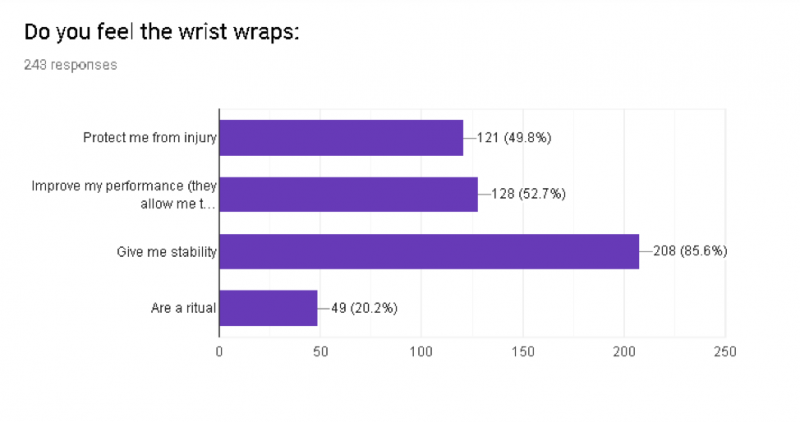
Can the Systematic Use of a Wrist Wrap Cause Muscle Weakness?
There is no evidence that this can happen. What may happen is poor development of your perception concerning stability. If you use a tight and tough wrist wrap at all times, you won’t identify what is the threshold load for your control and stability. If you have hypermobility and it creates severe instability, the threshold will be a low weight and you will want to use a wrist wrap even during warm up. That is not common for the majority of people and even less, the majority of high-performance benchers.
Not using a wrist wrap on light weights because of a misconception (or because some “bro” thinks it’s tougher not to use protective equipment) can and probably will make you vulnerable to injury.
Psychological Benefit and Ritual
About 20% of the respondents associated the use of wrist wraps to a ritual aspect of their lifting.
Takeaways
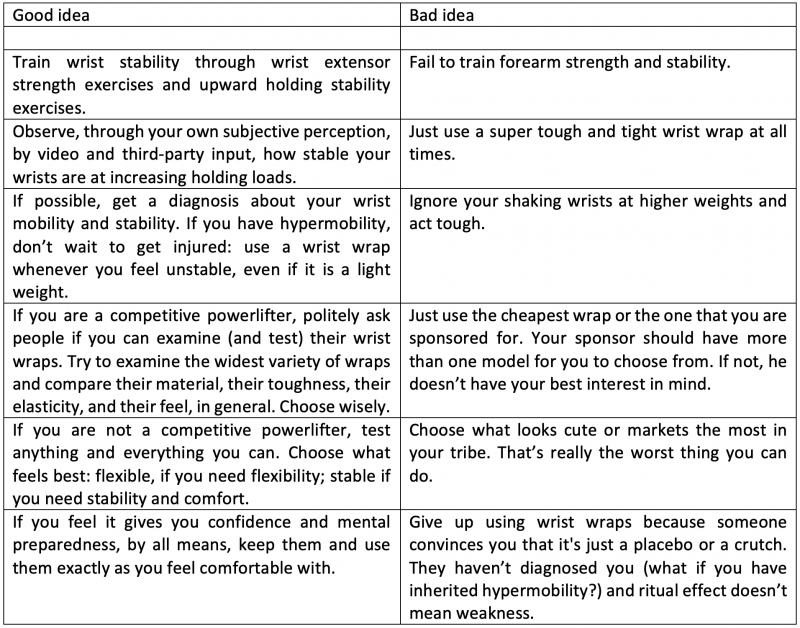
Bottom line: “know thyself”.
References
- Carlsen, B. T., and Alexander Y. Shin. "Wrist instability." Scandinavian Journal of Surgery 97, no. 4 (2008): 324-332.
- Drosness, V. 1901. Patent: WRISTBAND; Patent number: 680477. Filing date: Jun 14, 1901. Issue date: Aug 1901. Inventor: VITOLD DROSNESS
- Ercolani, Mauro, Matteo Galvani, Cristina Franchini, Federica Baracchini, and Rabih Chattat. "Benign joint hypermobility syndrome: psychological features and psychopathological symptoms in a sample pain-free at evaluation." Perceptual and motor skills 107, no. 1 (2008): 246-256.
- Field, Larry D., and Felix H. Savoie. "Common elbow injuries in sport." Sports medicine 26, no. 3 (1998): 193-205.
- Frostick, Simon P., Mohammad Mohammad, and David A. Ritchie. "Sport injuries of the elbow." British journal of sports medicine 33, no. 5 (1999): 301.
- Hansard, H.H. 1923. Patent: WRIST SUPPORT. Patent number: 1469315. Filing date: Aug 25, 1921. Issue date: Oct 1923; Inventor: H. H. HANSARD
- Keogh, Justin, Patria A. Hume, and Simon Pearson. "Retrospective injury epidemiology of one hundred one competitive Oceania power lifters: the effects of age, body mass, competitive standard, and gender." Journal of Strength and Conditioning research 20, no. 3 (2006): 672.
- Malfait, F. R. A. N. S. I. S. K. A., A. J. Hakim, Anne De Paepe, and R. Grahame. "The genetic basis of the joint hypermobility syndromes." Rheumatology 45, no. 5 (2006): 502-507.
- McKeon, Kathleen E., Daniel A. London, Daniel A. Osei, Richard H. Gelberman, Charles A. Goldfarb, Martin I. Boyer, and Ryan P. Calfee. "Ligamentous hyperlaxity and dorsal wrist ganglions." The Journal of hand surgery 38, no. 11 (2013): 2138-2143.
- Rettig, Arthur C. "Elbow, forearm and wrist injuries in the athlete." Sports Medicine 25, no. 2 (1998): 115-130.
- Robinson. C.H. 1975. Patent: Athletic hand/wrist positioner Patent number: 4138108. Filing date: Aug 15, 1975. Issue date: Feb 6, 1979. Inventor: Charles H. Robinson.
- Russek, Leslie N., and Deanna M. Errico. "Prevalence, injury rate and, symptom frequency in generalized joint laxity and joint hypermobility syndrome in a “healthy” college population." Clinical rheumatology 35, no. 4 (2016): 1029-1039.
- Safran, Marc R. "Elbow injuries in athletes." Clinics in sports medicine 23, no. 4 (2004): xvii-xix.
- Strömbäck, Edit, Ulrika Aasa, Kajsa Gilenstam, and Lars Berglund. "Prevalence and Consequences of Injuries in Powerlifting: A Cross-sectional Study." Orthopaedic journal of sports medicine 6, no. 5 (2018): 2325967118771016.
- Tyrrell, J. 1909. Patent: WRIST-SUPPORTER. Patent number: 923217. Filing date: Jun 16, 1908.Issue date: Jun 1909. Inventor: JAMES TYRRELL
- Walunga, A.R. 1990. Patent: Combined workout glove and wrist wrap. Patent number: 4905321. Filing date: Apr 7, 1988. Issue date: Mar 6, 1990. Inventor: Allen R. Walunga. Assignee: Allen R. Walunga. Primary Examiner: Jeanette E. Chapman.











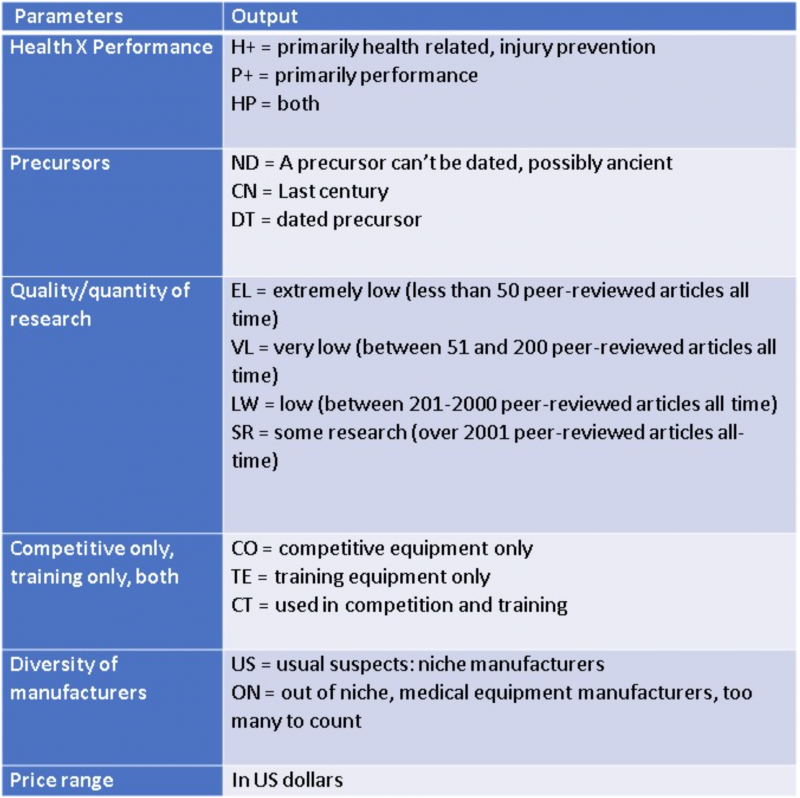
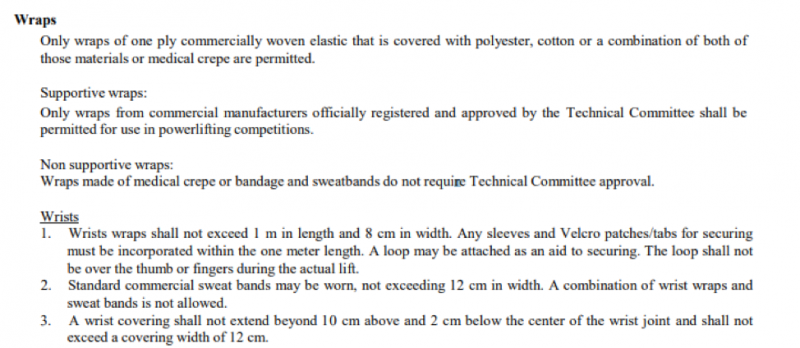
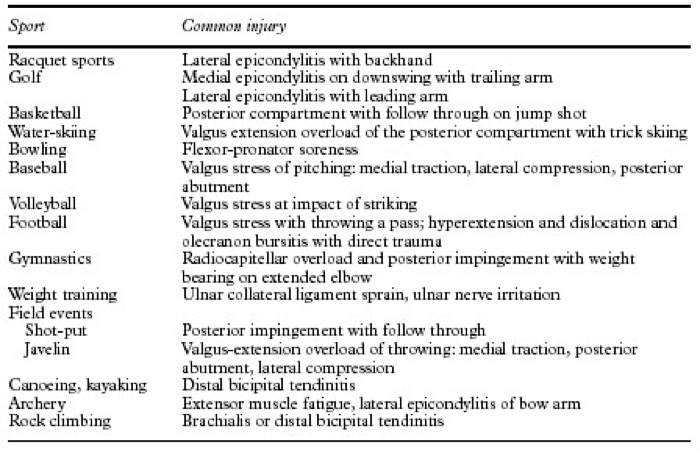
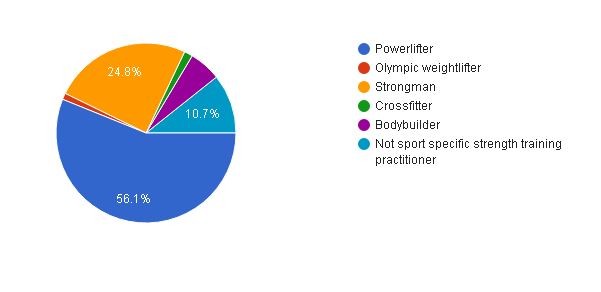

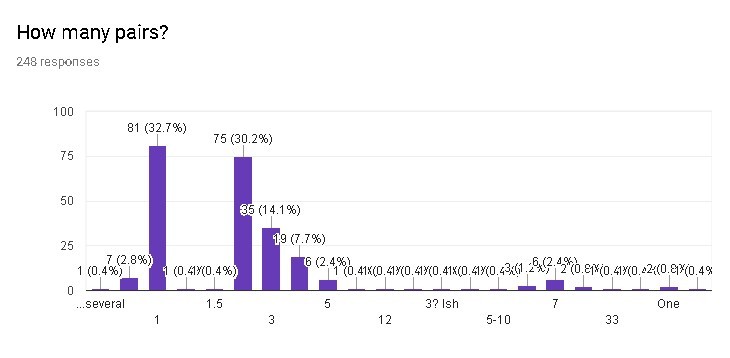
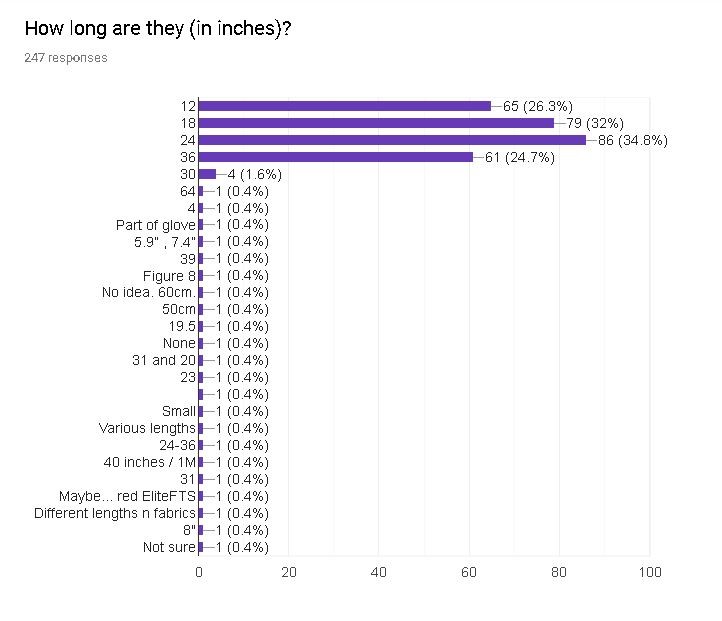
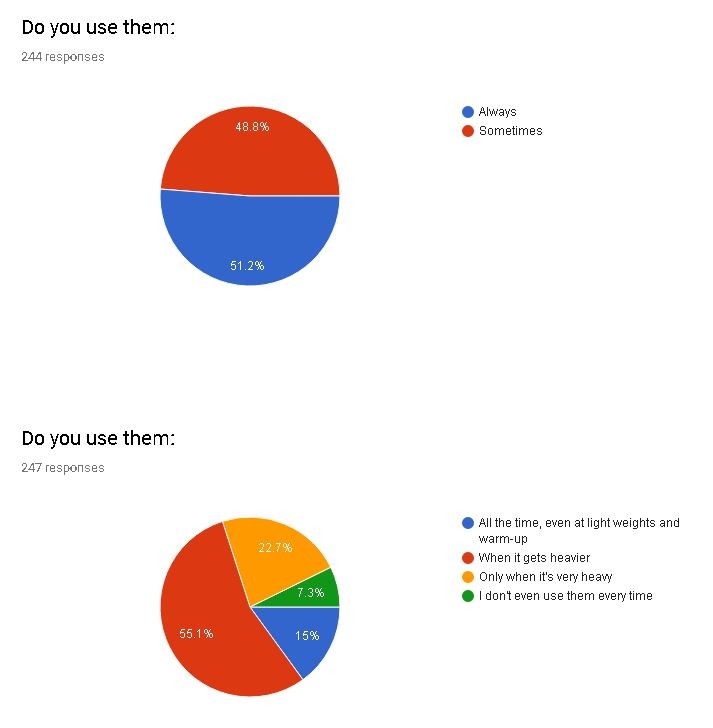

1 Comment